15 to 18 April, 2013 – Stepanakert, Agdam – (Nagorno-Karabakh)
You may struggle to find Nagorno-Karabakh on many maps. Officially, it does not really exist. My understanding is, and this may be not quite correct, Nagorno-Karabakh is a region that was majority inhabited by people of Armenian descent (and a significant majority, somewhere over 90% at the start of the 20th century, and still over 75% in the 1980s). During the time of the Soviet Union, the region was included as part of Azerbaijan. In the late 80's, the Armenians there sought independence from Azerbaijan, which turned in to war. Armenia supported them, and by 1994 a ceasefire was called and a tentative ceasefire line exists. To this day, Nagorno-Karabakh still remains largely unrecognised as a sovereign entity, and for most maps and international recognition it is part of Azerbaijan. For practical reasons, it needs to be seen as part of Armenia, as this is the only point of access for foreigners, they speak Armenian, use Armenian currency, and rely on the support of the Armenian military, government, and people. But they seek to be viewed as an independent and sovereign nation, using the names Nagorno-Karabakh, or just Karabakh, or even Artsakh at times.
So, visiting the area was interesting, with some areas quite enigmatic. We mainly stayed in the region that is marked out as Nagorno-Karabkh, but we did venture across to some other areas claimed by Azerbaijan, not part of Nagorno-Karabakh, but still under control of the Armenian military and on the Armenian side of the cease-fire line. I interpret this as a sort of dead zone, or buffer, not ultimately part of Karabakh's claim, not quite a no-man's land, and all in limbo until a final solution can be ratified regarding the status of the entire zone.
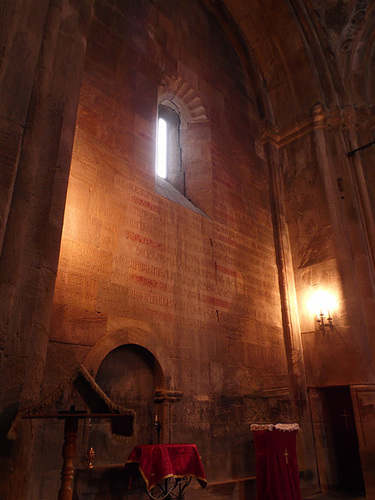
Gandzasar Monastery
Writing from centuries past adorns the interior walls of the main church in the Gandzasar monastery near Vank in Nagorno-Karabakh.
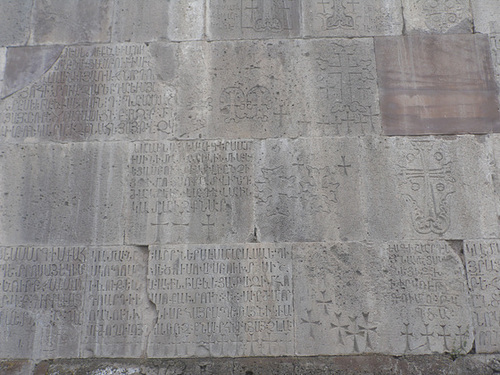
Gandzasar Monastery
Over time, crosses have been etched in to the exterior walls. Gandzasar monastery, Vank, Nagorno-Karabakh.
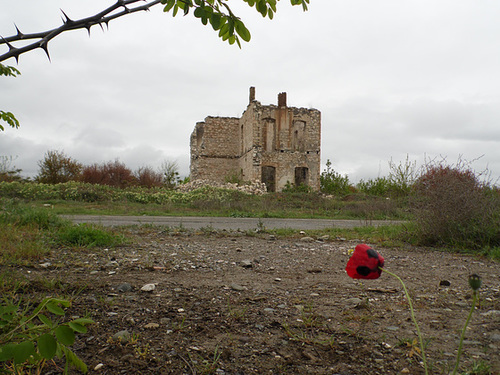
A Poppy Grows
Coming in to Agdam, a ruined and abandoned city, we found poppies growing by the roadside. Agdam, or Akna, is not really in Nagorno-Karabakh, but in Azerbaijan territory occupied by the Armenian military. Not quite no-man's land, but a dead zone for all intents and purposes, until the entire Karabakh question is resolved.
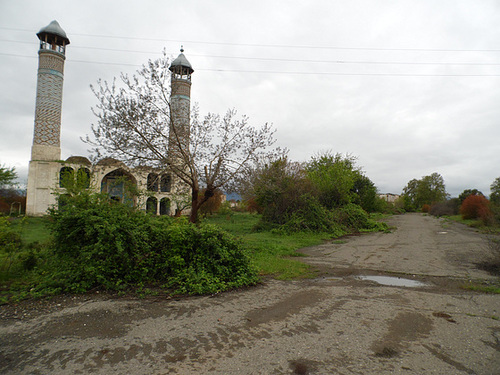
The Mosque In Agdam
Abandoned and in disrepair, the mosque near the centre of Agdam is one of the few buildings to retain its form and whose original function is discernible. It is still possible to access the roof and to climb the minarets. The street was a main road, but is slowly giving in to the encroachment of trees and shrubs.
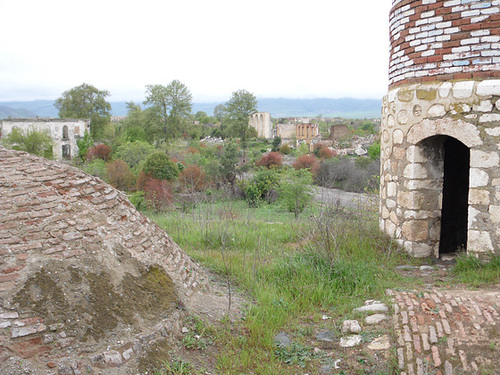
Looking To Town Centre
From the roof of the abandoned mosque in Agdam, looking towards some of the remains of the buildings that were once part of the centre of town.

Abandoned and Plundered
Another photo taken from the roof of the mosque in Agdam. The remains of the low rise housing, mainly one and two storey buildings, are slowly being engulfed by the trees. Every building has been picked through many times, firstly for anything resalable including bathroom and kitchen fittings, and secondly for anything recyclable, particularly scrap metals and building materials. Amongst all the things left behind are occasional stoves and refrigerators, as well as the shells of cars and trucks.
You may struggle to find Nagorno-Karabakh on many maps. Officially, it does not really exist. My understanding is, and this may be not quite correct, Nagorno-Karabakh is a region that was majority inhabited by people of Armenian descent (and a significant majority, somewhere over 90% at the start of the 20th century, and still over 75% in the 1980s). During the time of the Soviet Union, the region was included as part of Azerbaijan. In the late 80's, the Armenians there sought independence from Azerbaijan, which turned in to war. Armenia supported them, and by 1994 a ceasefire was called and a tentative ceasefire line exists. To this day, Nagorno-Karabakh still remains largely unrecognised as a sovereign entity, and for most maps and international recognition it is part of Azerbaijan. For practical reasons, it needs to be seen as part of Armenia, as this is the only point of access for foreigners, they speak Armenian, use Armenian currency, and rely on the support of the Armenian military, government, and people. But they seek to be viewed as an independent and sovereign nation, using the names Nagorno-Karabakh, or just Karabakh, or even Artsakh at times.
So, visiting the area was interesting, with some areas quite enigmatic. We mainly stayed in the region that is marked out as Nagorno-Karabkh, but we did venture across to some other areas claimed by Azerbaijan, not part of Nagorno-Karabakh, but still under control of the Armenian military and on the Armenian side of the cease-fire line. I interpret this as a sort of dead zone, or buffer, not ultimately part of Karabakh's claim, not quite a no-man's land, and all in limbo until a final solution can be ratified regarding the status of the entire zone.

Gandzasar Monastery
Writing from centuries past adorns the interior walls of the main church in the Gandzasar monastery near Vank in Nagorno-Karabakh.

Gandzasar Monastery
Over time, crosses have been etched in to the exterior walls. Gandzasar monastery, Vank, Nagorno-Karabakh.

A Poppy Grows
Coming in to Agdam, a ruined and abandoned city, we found poppies growing by the roadside. Agdam, or Akna, is not really in Nagorno-Karabakh, but in Azerbaijan territory occupied by the Armenian military. Not quite no-man's land, but a dead zone for all intents and purposes, until the entire Karabakh question is resolved.

The Mosque In Agdam
Abandoned and in disrepair, the mosque near the centre of Agdam is one of the few buildings to retain its form and whose original function is discernible. It is still possible to access the roof and to climb the minarets. The street was a main road, but is slowly giving in to the encroachment of trees and shrubs.

Looking To Town Centre
From the roof of the abandoned mosque in Agdam, looking towards some of the remains of the buildings that were once part of the centre of town.

Abandoned and Plundered
Another photo taken from the roof of the mosque in Agdam. The remains of the low rise housing, mainly one and two storey buildings, are slowly being engulfed by the trees. Every building has been picked through many times, firstly for anything resalable including bathroom and kitchen fittings, and secondly for anything recyclable, particularly scrap metals and building materials. Amongst all the things left behind are occasional stoves and refrigerators, as well as the shells of cars and trucks.
No comments:
Post a Comment